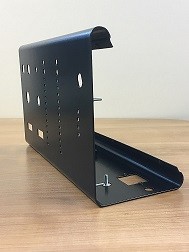Trouble Shooting Complex Bends
08 Mar 2018
From time to time, as many sub-contractors surely do, a job comes in which you look at and think ‘how can we do this to give the customer what he wants?’ This can be an interesting challenge which breaks up the normal day to day hum-drum of the factory environment, or it can be sheer frustration.
Sometimes, draughtsmen draw up weird and wonderful bends in jobs which as a sub-contractor we have to try and match as closely as possible. (We also think ‘why on earth would you do that instead of using the same 3 rads?’)
Typically we either: don’t have the exact tool that would help to achieve this; or there are other considerations which have a bearing on how we do the job. This could be the proximity of fasteners or holes, or other bend considerations.
The most recent bespoke project we undertook was a small multi radius cover, formed into a triangular profile which had joggled edges to allow a base plate to sit flush to the surface of the bottom 2 rads. The drawing specified all 3 rads as different sizes.
Under other circumstances a multi rad press-brake punch tool would easily solve this challenge, however as 2 of the radii have joggled edges immediately off the end of the rad, this will not do the job.
This left us with doing a process called bump radius bending. Basically a sequence of shallow or open bends forming the required larger radius in a number of shallower steps. Fortunately this is a built in function of our press-brake cad cam program so a lot of the head-aches are done for us. However this still requires extensive test bending to fine tune the bend to fit the profile, particularly as this job is in aluminium with its inherent grain differences. As the part was reasonably small, we were able to print and laminate a 1 to 1 profile picture to easily check as we tested the bends. Once the part matched the profile picture, we were set to successfully and consistently produce the parts to customer requirement.

